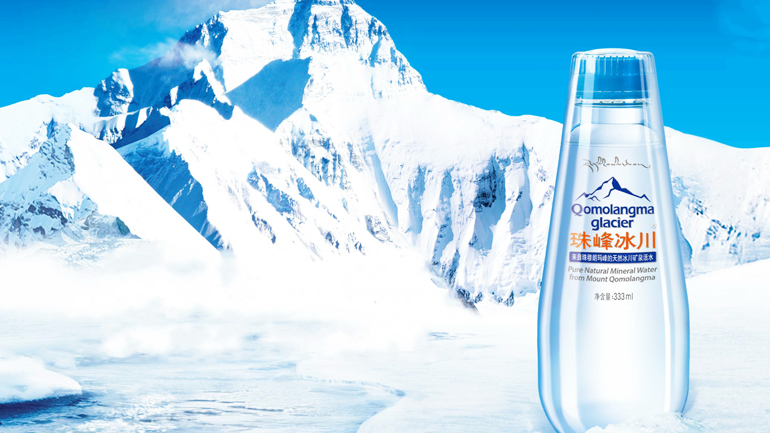
China is so vast, it quickly becomes the largest market for almost anything it consumes. Such is the case with bottled water. Chinese drink 40 billion litres of the stuff each year, up over 13-fold since 1998. That growth has a long way to go if China ever consumes as much per person as Mexico.
中国太大了,很快就会成为它所消费的几乎任何东西的最大市场,瓶装水也是如此。中国人每年喝掉的瓶装水有400亿升,是1998年的13倍以上。如果中国人均消费瓶装水的数量达到墨西哥的水平,那么这样的增长势头还将长期保持下去。
But finding clean supplies is difficult; rivers, lakes and even groundwater in China are often foul. Hence the huge demand for a seemingly inexhaustible source of pristine water that is cheap to extract, sells at a premium and can now, thanks to massive investment in infrastructure, be taken to coastal cities: Tibetan glaciers.
寻找干净水源是件困难的事情;中国的河流、湖泊甚至地下水往往水质糟糕。于是出现了对看似取之不尽用之不竭的一种纯净天然水源的巨大需求:西藏冰川。由于在基础设施上的巨大投入,这种水的提取成本低、售价高,而且现在可以运到沿海城市。
Tibet already sells Qomolangma Glacier water. Last year Sinopec, a state-owned energy group, put another brand on sale at its petrol stations: Tibet 5100. The Tibetan government has licensed 28 more companies to increase the province's bottling capacity 50-fold by 2020.
西藏已经在售卖珠穆朗玛冰川水。去年,国有能源集团中石化在自己的加油站出售另一种品牌的西藏冰川水:Tibet 5100。西藏政府已经批准了超过28家公司在该地区从事瓶装水生产活动,在2020年之前,让西藏的瓶装水生产能力达到目前的50倍。
Assuming companies do not mine the glacier ice itself, they will bottle only the meltwater that flows out of glaciers in summer. It is true that Himalayan glaciers on the Tibet-Qinghai plateau have retreated over the past 30 years by about 15%. But this is because of climate change. Bottling will not cause them to lose mass any quicker.
假设这些公司不会开采冰川本身,而只是将夏天融化的冰川水装瓶。的确,最近30年来,喜马拉雅冰川后撤了大约15%,但这是因为气候变化,瓶装水行业不会让冰川以更快的速度流失。
Nor will the bottled-water industry have much impact on the volume of water that flows from Tibet—a crucial source for neighbouring countries as well as China itself. About 1 billion people depend on the giant rivers—the Yellow river, the Brahmaputra, the Indus, the Ganges, the Yangzi, the Mekong and the Salween—that rise in the Himalayas, a region with the largest reserves of fresh water after the north and south poles. The manufacturing of bottled water consumes three times more water than ends up being sold. Yet even the projected expansion of Tibet's bottled-water output would amount to only a tiny fraction of the region's runoff.
这一行业也不会对从西藏流出的水量产生多大影响,这些水是中国和一些邻国至关重要的水源。约10亿人靠着源自于喜马拉雅地区的巨大河流——黄河、布拉马普特拉河、印度河、恒河、长江、湄公河以及萨尔温江——生活。喜马拉雅地区是仅次于南北极的最大淡水储存区,瓶装水生产过程消耗的水量是最终销售的水量的3倍。不过就算是西藏瓶装水产量将要扩大,对于该地区流出的水量来说,也只占很小的一部分。
More worrying is the possible threat that the industry will pose to the Tibetan environment. The bottling industry may spawn other, heavy-polluting ones, on the plateau, for the production of bottles and the plastic they use.
相比之下,更令人担忧的是该行业有可能给西藏环境带来的威胁。瓶装水行业有可能因为生产瓶子和瓶子所使用的塑料等环节给西藏带来其他高污染行业。
Tibet's government is bribing bottlers with tax cuts, tax holidays and cheap loans. It charges companies only 3 yuan to extract a cubic metre of water, compared with up to 50 yuan elsewhere. But the government in Beijing may have other plans. Alarmed by water scarcity, it wants to reduce groundwater extraction. It has plans for a nationwide cap in 2020 and wants all provinces—even water-rich ones like Tibet—to set quotas for water use. This may make Tibet's policies unsustainable.
西藏政府正在用减税、免税期和低息贷款等方式吸引瓶装水厂家。厂家每提取1立方米的水,政府只收取3元钱费用,相比之下,其他地方的收费高达50元。不过中国政府可能有着其他的考虑,因为担心水资源短缺,政府想要减少对地下水的抽取。它计划在2020年推出全国性的用水上限,要求各省份制定水资源使用的配额,这可能会让西藏当前的政策难以持续。
In Jilin province in the north-east, the local government had even more ambitious plans than Tibet's for ramping up mineral-water production. But it was forced to cut them by half because of mandated quotas.
在吉林省,当地政府甚至制定了比西藏更雄心勃勃的计划,要加大矿泉水的生产。但是由于政府规定的配额,吉林省不得不将矿泉水的产量减少一半。



 闽公网安备 35020302035673号
闽公网安备 35020302035673号
0 responses on "Tibetan glaciers become lucrative treasure for bottled water"